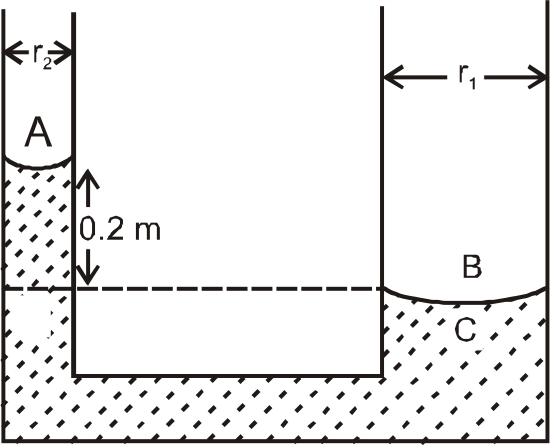The limbs of a manometer consist of uniform capillary tubes of radii 1.4×10−3mand7.2×10−4m. The correct pressure when the level of the liquid in the narrower tube stands 0.2m above that in the broader tube is X(621Pa). Find the value of X. (density = 103kg/m3, surface tension =72×10−3 N/m)Solution in Telugu
The correct Answer is:3
Step by step video, text & image solution for The limbs of a manometer consist of uniform capillary tubes of radii 1.4 xx 10^(-3) m and 7.2 xx 10^(-4) m. The correct pressure when the level of the liquid in the narrower tube stands 0.2m above that in the broader tube is X(621Pa). Find the value of X. (density = 10^3 kg//m^3, surface tension = 72 xx 10^(-3) N/m) by Physics experts to help you in doubts & scoring excellent marks in Class 11 exams.
Updated on:21/07/2023Topper's Solved these Questions
- SURFACE TENSIONBOOK - AAKASH SERIESCHAPTER - SURFACE TENSIONEXERCISE - PRACTICE SHEET ( EXERCISE-III Miscellaneous LEVEL - II STRAIGHT OBJECTIVE TYPE QUESTIONS)
7 Videos
- SURFACE TENSIONBOOK - AAKASH SERIESCHAPTER - SURFACE TENSIONEXERCISE - PRACTICE SHEET ( EXERCISE-III Miscellaneous LEVEL - II MORE THAN ONE CORRECT ANSWER TYPE QUESTIONS)
2 Videos
- SURFACE TENSIONBOOK - AAKASH SERIESCHAPTER - SURFACE TENSIONEXERCISE - PRACTICE SHEET ( EXERCISE-II LEVEL-II LINKED COMPREHENSION TYPE QUESTIONS)
7 Videos
- SIMPLE HARMONIC MOTION BOOK - AAKASH SERIESCHAPTER - SIMPLE HARMONIC MOTION EXERCISE - ADDITIONAL PRACTICE EXERCISE (LEVEL - II)(PRACTICE SHEET (ADVANCED)) (INTEGER TYPE QUESTIONS)
3 Videos
- SYSTEM OF PARTICLES AND ROTATIONAL MOTIONBOOK - AAKASH SERIESCHAPTER - SYSTEM OF PARTICLES AND ROTATIONAL MOTIONEXERCISE - PRACTICE EXERCISE
99 Videos
Similar Questions
When ‘n’ identical droplets are combined to form a big drop, then the energy will be released
If n identical small droplets each of radius r merge to form a big drop of radius R and the energy released in this process is absorbed by the big drop then rise in temperature (T be the surface tension, d be the density and S be the specific heat of the liquid droplets)
View SolutionIdentify the correct statement(s)
View SolutionWhen liquid medicine of density p is to be put in the eye, it is done with the help of dropper. As the bulb on the top of the dropper is pressed, a drop forms at the opening of the dropper. We wish to estimate the size of the drop. We first assume that the drop formed at the opening is spherical because that requires a minimum increase in its surface energy. To determine the size, we calculate the net vertical force due to the surface tension T when the radius of the drop is R. When the force becomes smaller than the weight of the drop, the drop gets detached form the dropper.
If the radius of the opening of the dropper is r, the vertical force due to the surface tension on the drop uf radius R (assumning <
View SolutionConsider the motion of a ball in a tunnel through the earth (radius of the earth is R and mass of the earth is M), the tunnel is along a chord and the ball is released from the surface. The time period of the ball is √x (approx), find x.
View SolutionThe centre of mass of two particles with masses 2kg and 6 kg located at (1,1,1), (2,2,1) respectively has the coordinates
View SolutionThe limbs of a manometer consists of uniform capillary tubes of radii 1.44×10−3m and 7.2×104m. If the level of the liquid in the narrower tube stands 0.2 m above that in the broader tube, pressure difference between A and B is found to be 310λN/m2. Here λ is an integer. Find λ (density = 103kg/m3, surface tension = 72×10−3N/m). (take g=9.8m/s2)

View SolutionThe limbs of a manometer consist of uniform capillary tubes of radii are 10−3&7.2×10−4m find out the correct pressure difference if the level of the liquid in narrower tube stands 0.2 m above that in the broader tube. (density of liquid =103kg/m3, surface tension =72×10−3N/m)
View SolutionA barometer contains two uniform capillries of radii 1.44×10−3m and 7.2×10−4m. If the height of the liquid in the narrow tube is 0.2m more than that in the wide tube, calculate the true pressure difference. Density of liquid =103kg/m3, surface tension =72×10−3N/m and g=m/s2.
View SolutionIf water rises in a capillary tube upto 3 cm . What is the diameter of capillary tube (Surface tension of water =7.2×10−2N/m)
View SolutionA manometer tube contains mercury of density 13.6 xx 10^(3) kg m^(-3) . What difference in the levels of mercury in the two arms is indicated by a gauge pressure of 1.03 xx 10^(5) Pa ?
View SolutionIf a capillary tube of radius 2 xx 10^(-4) m is is dipped vertically in a water of surface tension 7 xx 10^(-2) N/m and density 10^(3) "kg/m"^(3) then the height to which water rises will be
View SolutionA capillary tube of internal radius 2×10−3 m immersed vertically in beaker containing a liquid rising in the capillary tube is 9×105 kg , the surface tension of the liquid is
View SolutionAlcohol of density 8 xx 10^(4) kg//m^(3) and surface tension 22 xx 10^(-3) N/m rises through a capillary tube of diameter 0.4 xx 10^(-3) m . The vertical height to which the alcohol will rise is ,
View SolutionA capillary tube of radius 0.03 mm is held vertically in a liquid of density 0.85×103 kg/m3 and surface tension 4×10−2 N/m. The angle of contact of liquid -glass is given by cosθ=0.5 then rise of liquid in the capillary tube is.?
View SolutionA capillary tube of diameter 0.4mm is dipped in a beaker containing mercury. If density of mercury is 13.6 xx 10^3 kg//m^3 , surface tension 0.49Nm^(-1) , angle of contact 135^@ , the depression of the meniscus in the capillary tube will be
View Solution
